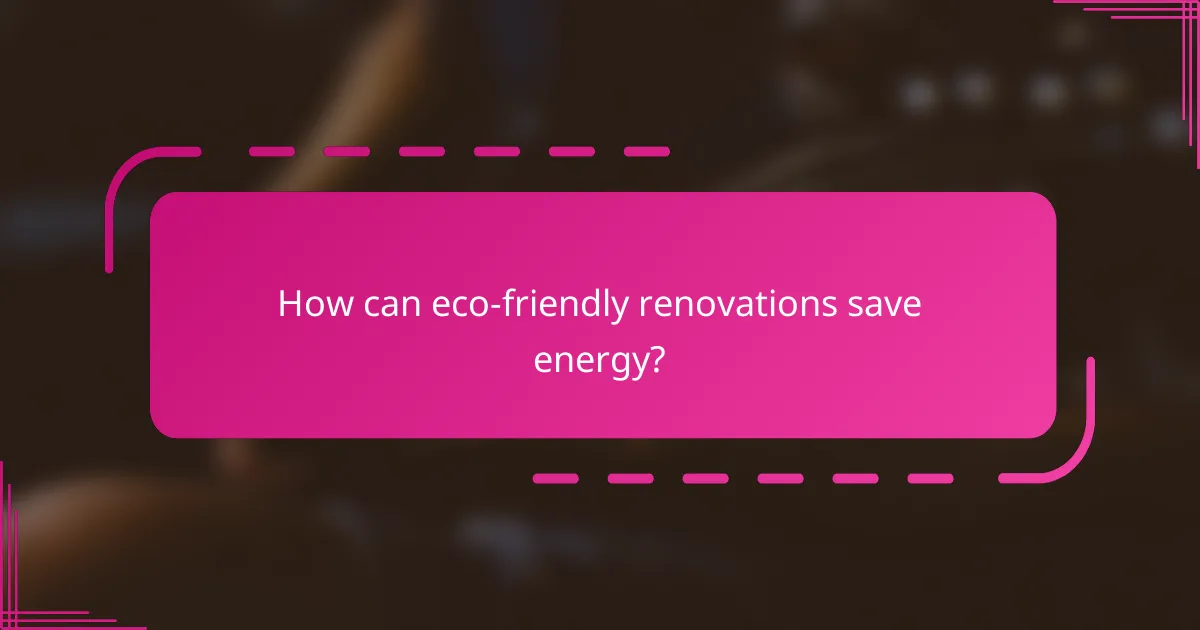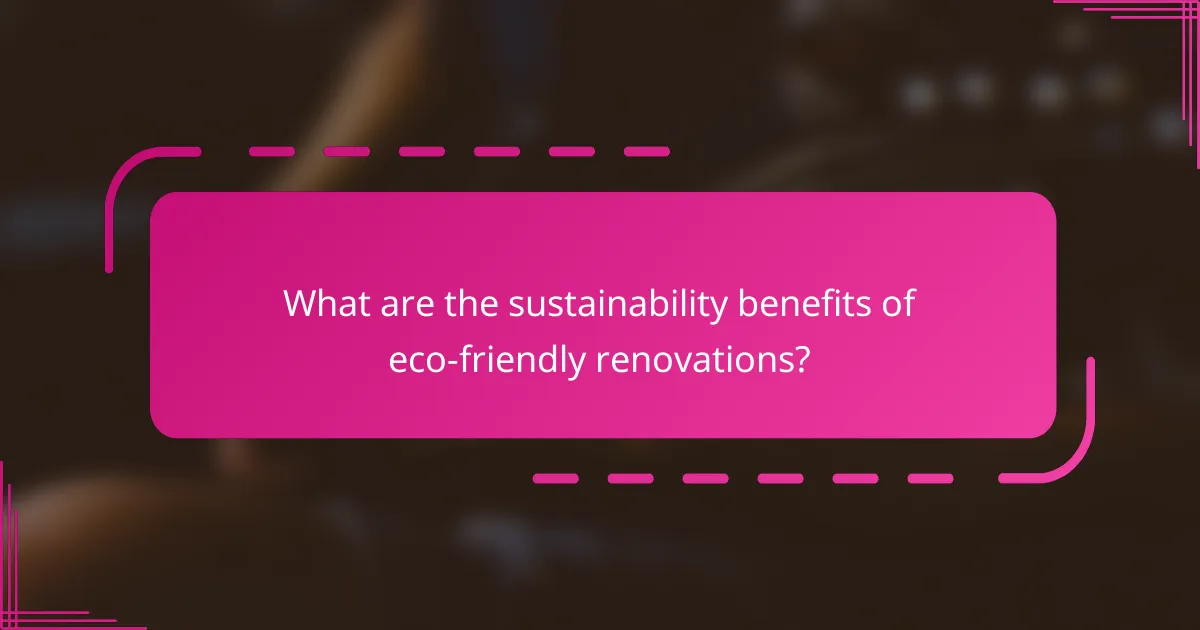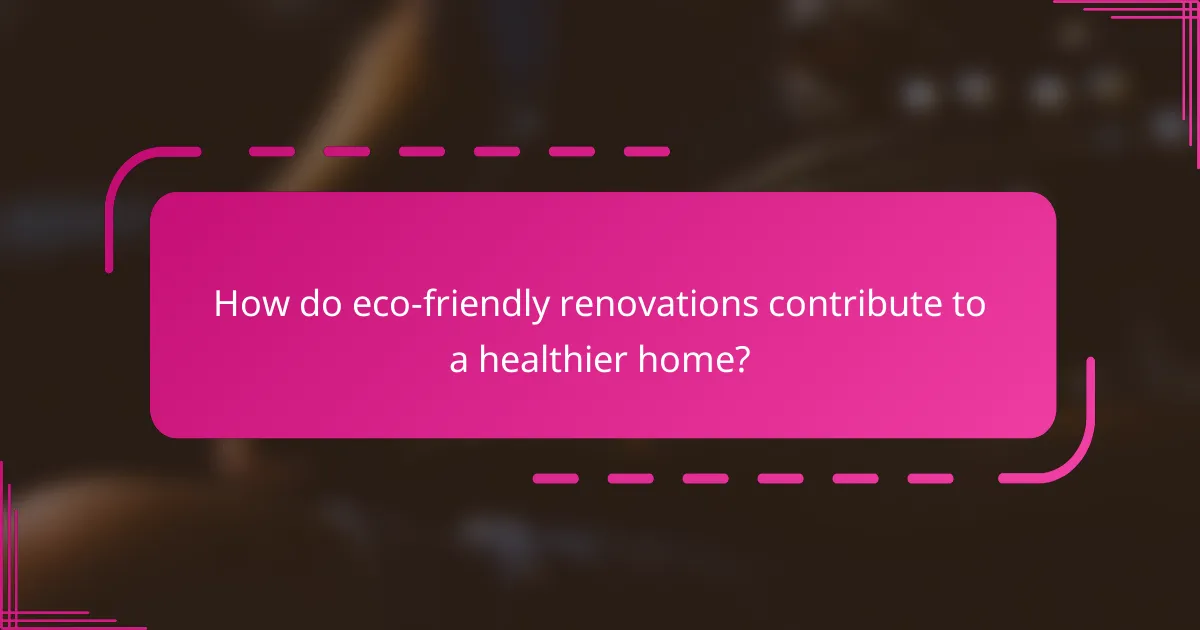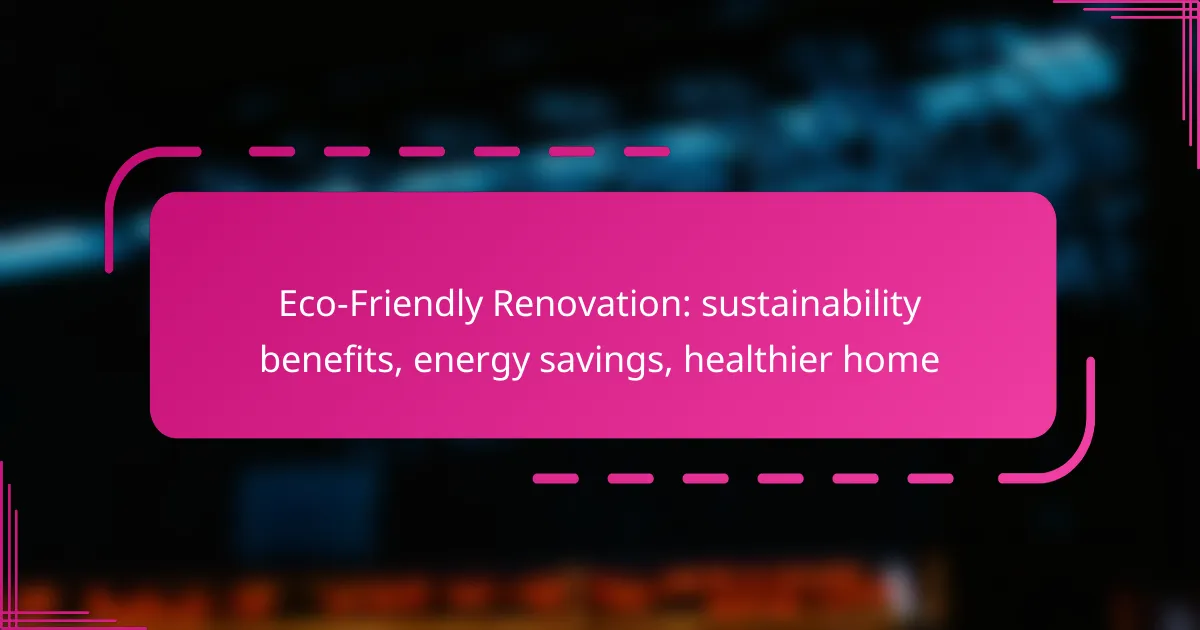Eco-friendly renovations provide a multitude of benefits, including significant energy savings and a healthier living environment. By utilizing sustainable materials and energy-efficient technologies, homeowners can reduce their utility bills while minimizing their environmental impact. Additionally, these renovations improve indoor air quality and promote overall well-being, creating a more pleasant and safe home.

How can eco-friendly renovations save energy?
Eco-friendly renovations can significantly reduce energy consumption by incorporating sustainable materials and technologies. By focusing on energy efficiency, homeowners can lower utility bills while contributing to environmental conservation.
Energy-efficient appliances
Upgrading to energy-efficient appliances is a straightforward way to save energy in your home. Look for appliances with the ENERGY STAR label, which indicates they meet strict efficiency guidelines. These appliances can reduce energy usage by 10-50% compared to standard models.
Common energy-efficient appliances include refrigerators, washing machines, and dishwashers. When replacing old appliances, consider their energy consumption ratings and choose models that fit your household needs while maximizing savings.
Insulation improvements
Enhancing your home’s insulation is crucial for maintaining temperature and reducing energy costs. Proper insulation in attics, walls, and floors can prevent heat loss in winter and keep your home cooler in summer, leading to lower heating and cooling expenses.
Consider using materials like spray foam, cellulose, or fiberglass batts for insulation upgrades. A well-insulated home can save up to 20% on heating and cooling costs, making it a worthwhile investment.
Solar panel installation
Installing solar panels can drastically reduce your reliance on traditional energy sources and lower your electricity bills. By converting sunlight into electricity, solar panels provide a renewable energy source that can power your home and even allow you to sell excess energy back to the grid in some regions.
When considering solar panel installation, evaluate your roof’s orientation, shading, and local regulations. The initial investment can vary widely, but many homeowners see a return on investment within 5-10 years through energy savings and potential tax incentives.

What are the sustainability benefits of eco-friendly renovations?
Eco-friendly renovations offer significant sustainability benefits by reducing environmental impact and promoting resource efficiency. These renovations help lower energy consumption, conserve natural resources, and enhance the overall health of living spaces.
Reduced carbon footprint
One of the primary sustainability benefits of eco-friendly renovations is the reduction of the carbon footprint. By using energy-efficient appliances, insulation, and renewable energy sources, homeowners can significantly decrease greenhouse gas emissions associated with their properties.
For example, switching to LED lighting and Energy Star-rated appliances can reduce energy consumption by 20-30%. Additionally, installing solar panels can further minimize reliance on fossil fuels, leading to a cleaner environment.
Conservation of natural resources
Eco-friendly renovations contribute to the conservation of natural resources by utilizing sustainable materials and practices. Choosing recycled, reclaimed, or sustainably sourced materials reduces the demand for new resources and minimizes waste.
For instance, using bamboo flooring or reclaimed wood not only lowers the environmental impact but also supports sustainable forestry practices. Implementing water-saving fixtures can also conserve water resources, which is crucial in areas facing water scarcity.
Increased property value
Investing in eco-friendly renovations can lead to increased property value. Homes with energy-efficient features and sustainable materials are often more attractive to buyers, who are increasingly prioritizing sustainability in their purchasing decisions.
Moreover, properties that meet green building standards may qualify for tax incentives or rebates, further enhancing their market appeal. Studies suggest that homes with eco-friendly upgrades can sell for 5-15% more than comparable properties without such features, making it a financially sound investment.

How do eco-friendly renovations contribute to a healthier home?
Eco-friendly renovations enhance home health by improving indoor air quality, utilizing non-toxic materials, and maximizing natural light. These changes not only create a more pleasant living environment but also promote well-being and reduce health risks associated with poor indoor conditions.
Improved indoor air quality
Renovating with eco-friendly practices can significantly enhance indoor air quality by reducing pollutants and allergens. Using proper ventilation systems and energy-efficient appliances helps to circulate fresh air and eliminate harmful substances. Consider installing air purifiers or using low-VOC paints to further improve air quality.
Regular maintenance of heating and cooling systems is essential. This includes changing filters frequently and ensuring ducts are clean, which can prevent dust and allergens from circulating throughout your home.
Use of non-toxic materials
Choosing non-toxic materials during renovations is crucial for a healthier home. Look for products labeled as low-VOC or free from harmful chemicals, such as formaldehyde. Common non-toxic options include bamboo flooring, recycled glass tiles, and natural fiber insulation.
When selecting paints, adhesives, and finishes, prioritize those that are certified by recognized standards, such as Green Seal or the EPA’s Safer Choice program. This not only protects your health but also contributes to a more sustainable environment.
Enhanced natural lighting
Maximizing natural light in your home can improve mood and reduce reliance on artificial lighting. Consider installing larger windows, skylights, or light tubes to allow more sunlight to enter your living spaces. This can also help lower energy costs by reducing the need for electric lighting during the day.
In addition to structural changes, using lighter colors for walls and furnishings can reflect more light, making spaces feel brighter and more inviting. Strategically placing mirrors can also amplify natural light, enhancing the overall ambiance of your home.

What are the costs associated with eco-friendly renovations?
The costs of eco-friendly renovations can vary widely depending on the scope of the project and the materials used. While the initial investment may be higher than traditional renovations, the long-term savings on energy bills and maintenance can make it a financially sound choice.
Initial investment vs. long-term savings
Eco-friendly renovations often require a higher upfront cost due to the use of sustainable materials and energy-efficient systems. For example, installing solar panels or high-efficiency windows can be expensive initially, but these investments typically lead to significant savings on utility bills over time.
Homeowners can expect to see energy savings ranging from 20% to 50% annually, depending on the improvements made. It’s essential to calculate the payback period for these investments, which can often range from 5 to 15 years, depending on local energy prices and the specific upgrades implemented.
Available tax incentives
Many governments offer tax incentives to encourage eco-friendly renovations, which can help offset the initial costs. In the United States, for instance, homeowners may qualify for federal tax credits for solar energy systems, energy-efficient appliances, and other green upgrades.
It’s crucial to research local and state incentives as well, as these can vary significantly. Homeowners should keep documentation of all renovations and consult with a tax professional to maximize potential savings through available credits and deductions.

What criteria should you consider when planning an eco-friendly renovation?
When planning an eco-friendly renovation, consider local building codes, material sourcing, and contractor experience. These criteria ensure that your project is compliant, sustainable, and executed by knowledgeable professionals.
Local building codes
Local building codes dictate the standards for construction and renovation in your area. Familiarize yourself with these regulations to ensure your eco-friendly renovation meets safety and environmental requirements.
Check for specific guidelines related to energy efficiency, waste management, and sustainable materials. Non-compliance can lead to fines or the need for costly modifications.
Material sourcing
Choosing sustainable materials is crucial for an eco-friendly renovation. Look for locally sourced, recycled, or certified sustainable products to minimize environmental impact.
Consider materials like bamboo flooring, reclaimed wood, or low-VOC paints. These options not only reduce your carbon footprint but can also enhance indoor air quality.
Contractor experience
Hiring a contractor with experience in eco-friendly renovations is essential for a successful project. They should be knowledgeable about sustainable practices and materials, as well as local regulations.
Ask for references and examples of previous eco-friendly projects. A qualified contractor can help you navigate challenges and maximize the sustainability of your renovation.

What are some popular eco-friendly renovation materials?
Popular eco-friendly renovation materials include options that minimize environmental impact while enhancing energy efficiency and indoor air quality. These materials not only contribute to sustainability but also often lead to cost savings in the long run.
Recycled materials
Recycled materials are a key component of eco-friendly renovations, as they repurpose waste products into new building materials. Common examples include reclaimed wood, recycled metal, and glass. Using these materials can significantly reduce the demand for new resources and lower landfill waste.
When selecting recycled materials, ensure they meet local building codes and standards. Look for certifications that indicate the material’s recycled content, such as the Forest Stewardship Council (FSC) for wood products. This helps guarantee that the materials are both sustainable and safe for use in your home.
Bamboo flooring
Bamboo flooring is an increasingly popular eco-friendly option due to its rapid growth and renewability. Unlike traditional hardwoods, which can take decades to mature, bamboo can be harvested in just a few years, making it a sustainable choice for flooring. Additionally, bamboo is naturally resistant to moisture and pests, which can enhance its durability.
When considering bamboo flooring, look for products that are certified by organizations like the Sustainable Forestry Initiative (SFI) to ensure responsible sourcing. Installation can be straightforward, but be aware of potential expansion and contraction with humidity changes, so proper acclimatization is essential before installation.
